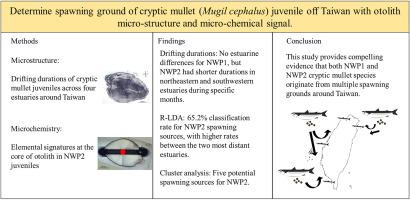用耳石显微结构和微化学信号确定台湾隐鲻鱼幼鱼的产卵场
IF 2.6
3区 地球科学
Q1 MARINE & FRESHWATER BIOLOGY
引用次数: 0
摘要
灰鲻鱼(Mugil cephalus)是台湾重要的渔业资源,由三种隐种(NWP1-3)共存于西北太平洋。然而,对物种特异性生物学特性的研究仍然有限。本研究以NWP2为研究对象,采用快速筛选技术对台湾周边4个河口的鲻鱼幼鱼进行了种类鉴定,并进行了耳石微观结构和微化学分析,以确定其产卵地。耳石日增量在各河口间NWP1漂移持续时间无显著差异,而NWP2在部分月份间存在显著差异,东北和西南河口的漂移持续时间明显较短。这些结果表明,NWP1缺乏地理梯度,而NWP2在漂流时间上呈现非单向地理梯度,这两种模式都支持台湾周围有多个产卵场的假设。鲁棒线性判别分析(R-LDA)表明,河口间NWP2产卵源的总体分类成功率为65.2%,其中最远的两个河口间的分类成功率较高。聚类分析进一步表明,NWP2可能来源于5个产卵源。五个产卵场元素特征的空间变异性可能反映了生理因素(如物种特异性敏感性)和环境条件(如淡水输入和水质量特征)的综合影响,为多个产卵场的位置提供了额外的证据。综上所述,本研究为了解不同隐鲻鱼种类的生活史和产卵行为提供了重要的见解,对台湾有效的渔业管理和保护策略具有重要意义。本文章由计算机程序翻译,如有差异,请以英文原文为准。

Determining spawning ground of cryptic mullet (Mugil cephalus) juvenile off Taiwan with otolith micro-structure and micro-chemical signal
Grey mullet, Mugil cephalus, is an important fisheries resource in Taiwan, comprising three cryptic species (NWP1-3) coexisting in the Northwest Pacific. However, studies of species-specific biological characteristics remain limited. This study employed rapid screening technique to identify species and conducted otolith microstructure and microchemical analysis on juvenile mullet collected from four estuaries around Taiwan to determine their spawning grounds with focused on NWP2. Otolith daily increments showed no significant differences in NWP1 drifting durations among estuaries, whereas NWP2 exhibited significant differences in partial months, with notably shorter durations observed in the northeastern and southwestern estuaries. These findings suggest that NWP1 lacks a geographic gradient, while NWP2 exhibits a non-unidirectional geographic gradient in drifting durations, with both patterns supporting the hypothesis of multiple spawning grounds around Taiwan. Robust Linear Discriminant analysis (R-LDA) showed that the overall successful classification rate for the spawning sources of NWP2 among estuaries was 65.2 %, with higher classification rates observed between the two farthest estuaries. Cluster analysis further indicated that NWP2 may originate from five spawning sources. Spatial variability in elemental signatures of five spawning sources likely reflects the combined influence of physiological factors (e.g., species-specific sensitivity) and environmental conditions (e.g., freshwater input and water mass characteristics), providing additional evidence for the location of multiple spawning grounds. Overall, this study provides important insights into the life history and spawning behavior of different cryptic mullet species, which is crucial for effective fisheries management and conservation strategies in Taiwan.
求助全文
通过发布文献求助,成功后即可免费获取论文全文。
去求助
来源期刊
CiteScore
5.60
自引率
7.10%
发文量
374
审稿时长
9 months
期刊介绍:
Estuarine, Coastal and Shelf Science is an international multidisciplinary journal devoted to the analysis of saline water phenomena ranging from the outer edge of the continental shelf to the upper limits of the tidal zone. The journal provides a unique forum, unifying the multidisciplinary approaches to the study of the oceanography of estuaries, coastal zones, and continental shelf seas. It features original research papers, review papers and short communications treating such disciplines as zoology, botany, geology, sedimentology, physical oceanography.

 求助内容:
求助内容: 应助结果提醒方式:
应助结果提醒方式:


